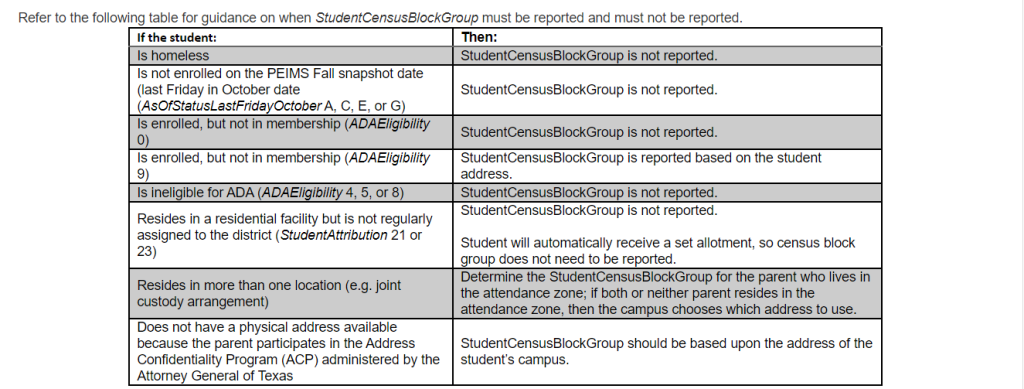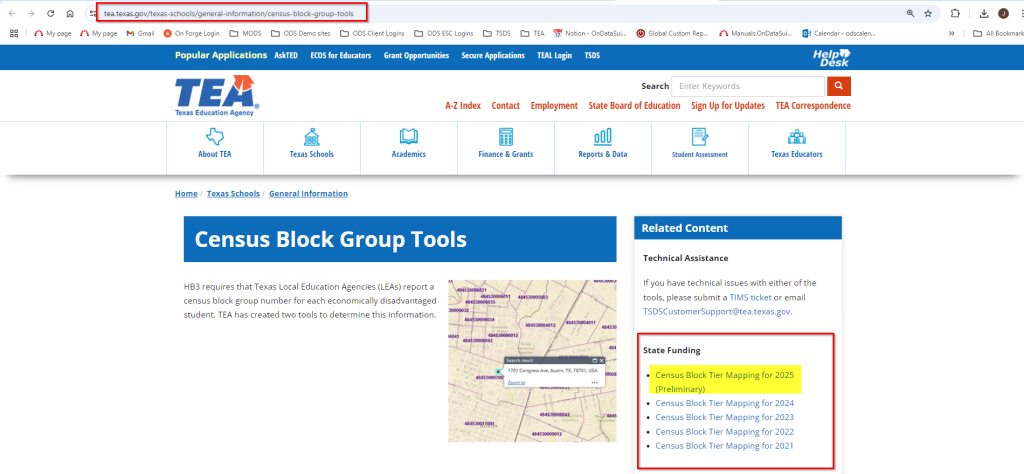State Compensatory Education (SCE)/Comp Ed Funding (reference TEC 48.104)
SCE Allotments are state funds, for supplemental programs and services, allocated to LEAs for 3 primary subpopulations:
- Individual Student coding determines funding eligibility:
- 1. For each student who does not have a disability and resides in a residential placement facility in a district in which the student’s parent or legal guardian does not reside, a district is entitled to an annual allotment equal to the basic allotment multiplied by 0.2 or, if the student is educationally disadvantaged, 0.275.
- 2. For each full-time equivalent student who is in a remedial and support program under Section 29.081 because the student is pregnant, a district is entitled to an annual allotment equal to the basic allotment multiplied by 2.41.
- 3. For each student who is educationally disadvantaged (economically disadvantaged)
AND resides in an economically disadvantaged census block group as determined by the commissioner is entitled to an annual allotment equal to the Basic Allotment x the weighted tier (Census Block Tiers) assigned to the individual student’s census block group.
Eligible students are determined to be educationally disadvantaged and are reported in the PEIMS Fall submission with a Student Census Block Group as defined in the TSDS Web-Enabled Data Standards (Reference section DR6 of the Student Entity)
- STUDENT-CENSUS-BLOCK-GROUP must be reported for students who are:
- economically disadvantaged (ECONOMIC-DISADVANTAGE-CODE 01, 02 or 99),
- AND enrolled on the PEIMS Fall snapshot date (last Friday in October) date (AS-OF-STATUS-CODE B, D, F, or X),
- AND eligible for ADA (ADA-ELIGIBILITY-CODE 1, 2, 3, 6, 7 or 9)
- AND student is not homeless (HOMELESS-STATUS-CODE 0)
- AND includes students (with or without a disability) who reside in a residential facility if they are regularly assigned to the LEA (STUDENT-ATTRIBUTION-CODE <> 21 or 23)
- STUDENT-CENSUS-BLOCK-GROUP must NOT be reported for students who are:
- not economically disadvantaged (ECONOMIC-DISADVANTAGE-CODE 01, 02 or 99)
- OR not enrolled on the PEIMS Fall snapshot date (last Friday in October),(AS-OF-STATUS-CODE A, C, E G, or X),
- OR not in membership, (except students enrolled, not in membership due to virtual learning)
- OR ineligible for ADA,
- OR homeless,
- OR residing in a residential facility but are not regularly assigned to the district.

Economically disadvantaged students’ census block groups are determined from student’s home address.
- If a census block group is not identified for an address (ie. new addresses/developments), eligible student(s) will be assigned the lowest funded tier weight (0.225) (Tier 1)
Homeless students and students residing in residential placement facilities not regularly assigned to the LEA are automatically assigned to the highest funded tier weight (0.275) (Tier 5).
- Census Block Groups are NOT reported on these students as they do not have a home address.
Census Block Tiers are assigned to Census Block Groups based upon the severity of poverty using the following factors:
(1) poverty measured by median household income,
(2) average educational attainment of population,
(3) percentage of single parent households, and
(4) the rate of home-ownership
(5) Other criteria determined to likely disadvantage students’ success (e.g., automatic Tier 5 for homeless students and students in residential facility not regularly assigned to LEA)

TEA evaluates Census Tiers for Compensatory Education funding annually and rebalances the assigned Census Block Groups to Census Tier. This may or may not change your Census Tier Funding year to year as reflected on the HB3 Compensatory Education Report.
The ODS report uses the latest published TEA Census Tier Mapping for the respective school year. https://tea.texas.gov/texas-schools/general-information/census-block-group-tools (right side under State Funding).

As of the 2022-2023 year, TEA has indicated a final rebalance will occur AFTER the Fall PEIMS is finalized. When the final updated Census Block Tier Mapping is posted ODS will load and reprocess all LEA’s Fall files for final updated Census Tiers for 24-25 funding. (projected in March/April)
24-25 Fall Timeline:

- As of 07/28/2023, TEA process was updated to match the Fall submission timeline and ODS loads the latest year mapping once TEA releases the final version. The following is the TEA notice of this process and timeline as released in 2023.
- The intended purpose of this SCE spreadsheet is for Local Education Agency use for calculating their preliminary State Compensatory Education Allotment (SCE) for the 2024 school year.
- This spreadsheet cannot be used as a final yearly calculation of your SCE allotment by campus or by district.
- Only after submission of Fall PEIMS counts are reviewed and reconciled will a new and rebalanced SCE tier to Census Block Group Code spreadsheet be provided for final tier assignments. This means that the list of SCE tier to Census Block Group Code assignment may change later in the year once PEIMS data has been factored in and prior to SCE allotment funding.
- ODS will watch for TEA’s final 20245 file in March/April 2025 and update this report accordingly.
